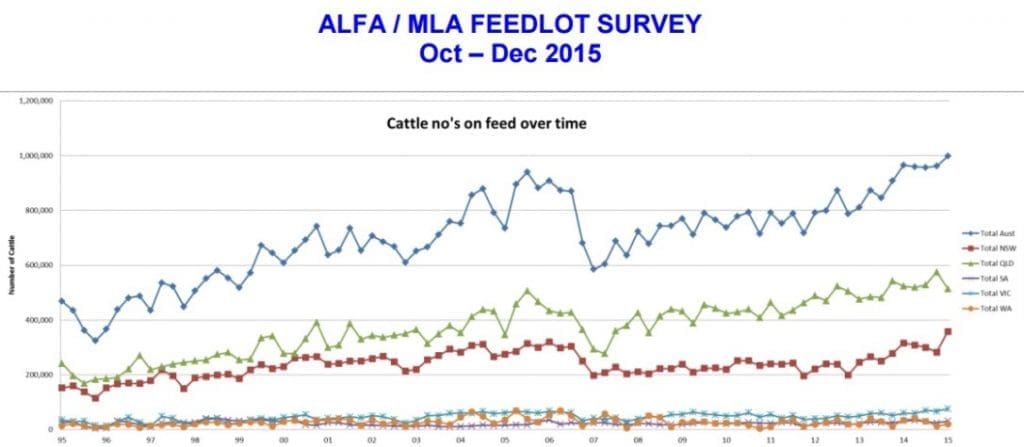NUMBERS on feed in Australian feedlots reached an all-time record high just short of a million head in the December quarter, latest grained survey statistics suggest.
The December quarter feedlot industry survey carried out by the Australian Lot Feeders Association and MLA suggests there were 997,765 head on feed at the end of December.
The result is almost 4 percent higher than the September figure, and 3.4pc up on this time last year.
Again, because of the considerable lag in the compilation and release of quarterly survey data, it perhaps does not capture the latest feeding trends. Anecdotal evidence from some the nation’s largest lotfeeders suggests numbers on feed have dropped so far this year, with some pens not being re-filled after close-out of the previous cycle.
That appears to apply particularly in yards offering custom feeding services for clients, where demand appears to have softened considerably since January.
The survey itself is not an exhaustive questionnaire contributed to by all lotfeeders, but is based on ‘statistically reliable’ sampling across different feedlot sizes. At least one of the nation’s largest lotfeeders chooses not to contribute data to the process.
On a breakdown by state, the survey suggests Queensland numbers on feed at 513,969 head were back 11pc in December from the previous quarter, and down 2pc year-on-year.
Somewhat surprisingly, NSW figures were reported at an all-time record of 358,068 head. If it’s accurate, it represents an extraordinary 27pc rise on the previous quarter, and 13pc higher than this time last year.
WA showed its normal seasonal increase, rising 30pc since September to 19,600 head, but the figure was only a little more than half the numbers on feed in December last year. Victoria showed a 12pc rise since September to 75,400 head, while South Australia rose 26pc to 30,700 head.
ALFA president Tess Herbert said she herself had been surprised by some of the results, especially the trend in NSW.
Having consulted with other stakeholders, she told Beef Central that part of the explanation appeared to be relatively cheaper feedgrain in NSW than Queensland during the reporting period, and somewhat cheaper feeder cattle prices. The growth trend in NSW was clearly skewed towards larger feedyards, with lots above 10,000 head in capacity accommodating 47,000 more cattle on feed in December over September results.
The NSW trend was also clearly reflected in capacity utilisation levels, rising from 77pc to 87pc in just three months. Utilisation in Queensland yards went sharply the other way, falling from 91pc in September to 78pc in December, the report suggested.
Ms Herbert said the overall December survey results reflected the decrease in the value of the A$ and grain prices. The A$ averaged US72¢ in the December quarter, a 16pc year-on-year decline. At the same time, Darling Downs wheat averaged $281/t in December, back 11pc, and sorghum decreased 8pc, to average $270/t for the last three months of the year.
Meat and Livestock Australia’s market information manager, Ben Thomas, said December quarter grainfed beef shipments were on par with the previous record quarterly volume set in 2006, with a little over 69,100 tonnes exported.
Japan continued to be the dominant market for Australian grainfed beef, taking just over 52pc of Australian shipments for the quarter. Korean exports continued to grow during the quarter, with 13,000t exported over the three months, up 40pc year-on-year.
“While the Queensland 100-day grainfed steer over-the-hook indicator finished the year below where it peaked at the end of September, it averaged 557¢/kg dressed weight during the quarter, up 133¢/kg year-on-year,” Mr Thomas said.
Ms Herbert said that it was expected that the first quarter of 2016 would ‘more than likely’ see a decreased number on feed, due to the high cattle prices and tighter supply. Those March quarter results will not be seen until well into May.




HAVE YOUR SAY